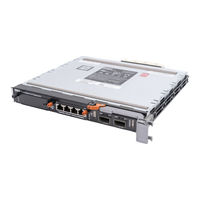Dell PowerEdge M IO Aggregator Manuals
Manuals and User Guides for Dell PowerEdge M IO Aggregator. We have 3 Dell PowerEdge M IO Aggregator manuals available for free PDF download: Command Reference Manual, Reference Manual, Getting Started Manual
Dell PowerEdge M IO Aggregator Command Reference Manual (290 pages)
MXL 10/40GbE Switch IO Module FTOS Command Reference Guide, FTOS 8.3.16.1
Table of Contents
-
-
Objectives15
-
Audience15
-
Conventions16
-
-
-
Vlans20
-
Uplink LAG20
-
-
Front Panel34
-
Boot Process37
-
-
-
Logging53
-
-
-
-
DCBX Example81
-
-
DHCP Client100
-
8 FIP Snooping
107 -
-
IGMP Overview123
-
IGMP Snooping127
-
-
10 Interfaces
131-
Interface Types132
-
Layer 2 Mode136
-
VLAN Membership140
-
Interface Range150
-
MTU Size155
-
-
-
Link Aggregation169
-
Uplink LAG169
-
LACP Modes170
-
-
LACP Example171
-
13 Layer
177 -
-
Overview181
-
Optional Tlvs182
-
LLDP Operation189
-
Debugging LLDP193
-
-
-
Entity MIBS214
-
17 Stacking
217-
Overview217
-
-
Failover Roles219
-
MAC Addressing220
-
Stacking LAG220
-
Stacking Vlans220
-
-
-
Using Leds226
-
-
-
-
-
-
Trace Logs265
-
Buffer Tuning271
-
Mini Core Dumps282
-
TCP Dumps284
-
-
-
IEEE Compliance285
-
Advertisement
Dell PowerEdge M IO Aggregator Reference Manual (264 pages)
Dell PowerEdge FTOS Command Line Reference Guide for the M I/O Aggregator
Table of Contents
-
-
-
Commands41
-
Clear Alarms42
-
Show Alarms51
-
Show Memory59
-
-
Show System68
-
Terminal Xml76
-
Undebug All78
-
-
-
-
6 U-Boot
81-
Overview81
-
Commands81
-
Show Bootvar87
-
-
-
Overview91
-
DCB Command91
-
PFC Commands91
-
ETS Commands91
-
-
-
9 FIP Snooping
115-
Overview115
-
-
11 Interfaces
129-
Overview129
-
-
Interface Range134
-
Interface Vlan138
-
Negotiation Auto141
-
Show Interfaces144
-
Show Range154
-
Show Tdr155
-
Show Vlan156
-
-
-
12 Ipv4 Routing
163-
IP Commands163
-
Debug Ip Icmp164
-
Management Route166
-
Show Hosts166
-
Show Arp167
-
Show Ip Route173
-
-
-
-
Overview179
-
Iscsi Commands179
-
-
-
Overview183
-
LACP Commands183
-
Debug Lacp184
-
Show Lacp184
-
-
-
15 Layer 2 | 185
187 -
-
Overview191
-
LLDP Commands191
-
-
-
Overview195
-
-
-
Monitor Session196
-
Show Config197
-
-
-
-
-
Overview201
-
-
19 Security
203-
Commands203
-
-
Enable Password204
-
Show Ip Ssh206
-
Show Users207
-
-
-
-
Overview211
-
SNMP Commands211
-
Syslog Commands211
-
Clear Logging212
-
Logging Buffered213
-
Logging Console213
-
Logging Facility214
-
Logging History215
-
Logging Monitor216
-
Logging Trap217
-
Show Logging218
-
-
-
-
Overview223
-
-
22 Storm Control
229-
Overview229
-
-
23 System Time
231-
Overview231
-
Time Commands231
-
Show Calendar232
-
Show Clock233
-
Clock Set234
-
Clock Timezone237
-
-
-
-
Overview239
-
UFD Commands239
-
Dell PowerEdge M IO Aggregator Getting Started Manual (38 pages)
Dell PowerEdge M I/O Aggregator Getting Started Guide
Table of Contents
-
-
-
DCB Support26
-
-
-
Uplink LAG28
-
-
6 Next Steps
34
Advertisement
Advertisement


